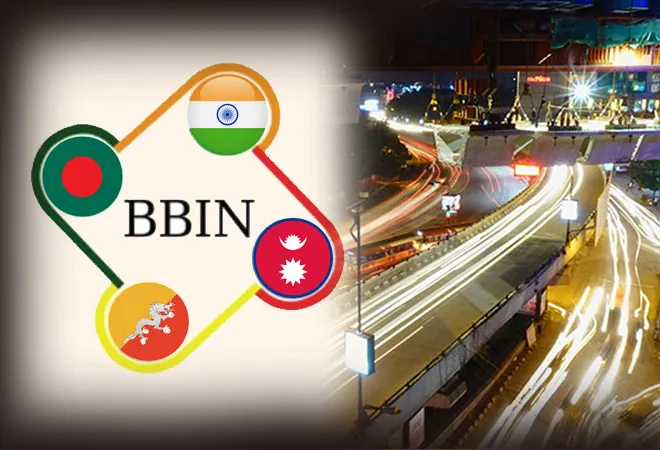
The much-anticipated Bangladesh-Bhutan-India-Nepal Motor Vehicles Agreement (BBIN-MVA) finally took a step forward on 7-8 March 2022, as the stakeholder countries congregated to actualise one of the long-pending connectivity aspirations of South Asia. Held in New Delhi, each country was well represented to arrive at a suitable conclusion for a Memorandum of Understanding (MoU) so that the pending ratification of the BBIN MVA can be achieved at the earliest. The meeting had put on the table a very crucial issue of commencing seamless passenger and cargo protocols for the regulation of passenger, personal and cargo vehicular traffic between the four respective countries, as had been signed on 15 June 2015. It must be mentioned at this juncture that Bhutan’s attendance for the discussion was only as an observer participant—the country that had previously opted out of the agreement because of its own issues of environment conservation, which it felt could be endangered by such a project. Even now, whether the Himalayan kingdom agrees to lend a hand or opts out shall affect the process intrinsically, along with robbing the country of the mutual developmental benefits that it could receive in return. As it seems even now, the country is unable to give its sanction, making the process tedious.
Relevance of the subregion and BBIN
Geographically placed in a categorical and unambiguous setting, the South Asian expanse has always helped itself to create a distinct niche of cynosure in the wider global Asia. In this underpinned notion, the increasing presence of several new geopolitical players and stakeholders, who have had their own set of interests, have explored several new embedded narratives of the region, including the concept of sub-regionalism.
Geographically placed in a categorical and unambiguous setting, the South Asian expanse has always helped itself to create a distinct niche of cynosure in the wider global Asia.
The BBIN has been envisioned as a similar growth quadrangle that has attempted to address the complementarities of the domain, with the utilisation of mutual assets like rivers, energy, infrastructures, solidified through a common framework of guidelines. Since there are only a few members, the process of addressing the diversities seems to be faster with a comparatively lower cost of investment. Such cooperation also appears to be non-exclusionary in nature as they do not compete with the larger regional arrangements, of which they might be a member as well. There is also a transfer of skill and technology from the more developed countries to the lesser developed countries through the spillover effect, which facilitates the up-gradation of skill sets and local labour force amongst all the partners. Furthermore, such sub-regional concepts also help in developing the backward and forward linkages in the national economy, thereby acting as a catalyst for triggering development in other parts of the economy as well.
Coming back to the BBIN as a potential thread of growth, it is primarily a coordinative architecture that operates through the ‘Joint Working Groups’ (JWG) comprising of the official representation from each of the members to formulate, implement and review quadrilateral agreements. The area of focus involves water resource management, connectivity of power grids, multi-modal transport and freight and transport infrastructure. The BBIN holds tremendous potential in bringing about an incremental boost in every sphere of development, from political, to economic and cultural. This idea must bring in the realisation that the process of coming together is inevitable for the collective growth of the four BBIN countries and also the region as a whole.
Even though the initiative is often perceived as primarily India-centric by the other members because of her gigantic size and economic prowess, these countries are largely eager to enhance consolidation within the sub-region, preserving their own social, economic, political, and cultural identity. This strategic thought process is the product of the sensed necessity of stronger ties, essential for the stability in this region. The constructive consequences of such a feasible partnership will not only pave the way to establish transport corridors but also will facilitate the flow of trade. Here, the relevance of the Motor Vehicle Agreement (MVA) is justified, and to understand whether it can address the sector-specific concerns or not. This is a very basic agreement with 16 Articles that has focused only on the transport of cargo and passengers. Such provisions are already present under the bilateral agreement with renewable permits and it does not cater to the regulatory bottlenecks and is also yet to bring in harmony. Some important agreements like the Customs Convention on International transport of goods, governed by the UN that would expedite the customs cooperation can be taken under the purview of consideration as well. India is the 71st contracting party, and it also enables standardised customs documents. In this regard, the TIR Convention must be taken into account, which will boost trade and regional integration across South Asia. TIR will help India to integrate Bangladesh, Nepal, Bhutan, Myanmar, as well as Thailand.
The area of focus involves water resource management, connectivity of power grids, multi-modal transport and freight and transport infrastructure.
The Asian Development Bank (ADB) has been proactive since a long time to incorporate stability in this particular aspect, with the provision of technical and knowledge support. All the four countries have been suggested to take the full advantage of ‘tourism potential’ with rich natural and cultural attractions, including many of the world’s major Buddhist sites. It is very recently that an amount of US$ 57. 5 million have been approved by the ADB Board of Directors in the form of grants and loans for the South Asia Tourism Infrastructure Development Project, to establish new and improved infrastructure along with the traditional services for key tourism sites in the four countries. If this sector brings about enhancement with the help of this investment, it would inevitably bring about an increment in the capacity of sector agencies for the sustainable management of these historical sites. At the same time, there would also be a sound involvement of the local people here, with the local communities, which again would be signifying a bottom-up approach of integration.
It seems relevant to mention here the same kind of aspiration by China as well, which has tried to focus on the tourism sector in South Asia with the help of the Belt and Road Initiative (BRI). There are thousands of Chinese tourists who come into these countries every year, either for a pilgrimage or for vacations . The probable rail connection, would simply add on to this trend. For instance, the bilateral trans-border rail connectivity between India and Bangladesh through Haldibari, 75 kilometres away from Chilahati across the border in Nilphamari district, has been refurbished after 55 years. In such a scenario, the idea lies in the integration if all the four countries in developing a separate tourism sector of their own with flow of Chinese tourists and also the other tourists from the rest of the world in accessing more economic benefit. This is especially true for the landlocked countries of Nepal and Bhutan, whose major part of the national economy is generated from tourism.
A country wise perspective has been explored below:
India: From the Indian perspective, the BBIN MVA will, most significantly, ease the movement of goods from mainland India to its Northeast economic centres, namely Agartala (Tripura), Guwahati (Assam), and Shillong (Meghalaya) along with the cross-country routes. Poor infrastructure, difficult terrain, insurgent politics, and geopolitical constraints have thus far kept the Northeast region underdeveloped and isolated for many years that can have better access with such progresses.
Bangladesh, Bhutan, and Nepal: The Bangladesh Inland Water Transport Authority and the Inland Waterways Authority of India, through the BBIN can work together, beyond the bilateral dynamics that it share. The economic benefits of this initiative will inadvertently support Bhutan and Nepal as well, through port connectivity, addressing their landlocked nature. Similarly, the transit rights shall also be recognised that remains in a deadlock.
Conclusion
All these programmes would be successful, in these trying times of the COVID-19 pandemic, when the world is trying to recuperate its economic and connectivity aspirations, only with all the members and stakeholders being on the same page of agreement. South Asia has witnessed the failure and stagnation of regional and subregional organisations in the recent past as well because of the lack of cooperation in upholding a common vision. However, time seems to be ripe to engage in micro-level projects like the BBIN, beginning from the Track 1 level, manifesting the visions that have been in the pipeline for operationalisation for years now.
The views expressed above belong to the author(s). ORF research and analyses now available on Telegram! Click here to access our curated content — blogs, longforms and interviews.




 PREV
PREV


